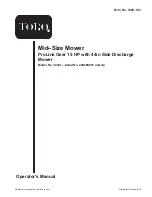
Operating Instructions
D21d
50
Clogging Checklist
In case of clogging, there will be a
distinct change
in the sound
of the blower, i.e., the blower sound
will stop. Also, the mower deck will begin to leave
a trail of grass clippings. When this occurs, stop
the engine, disconnect the electrical plug on the
fuel shut-off solenoid, and make
sure all move-
ment has stopped before attempt ing to unclog.
DANGER
NEVER place hands under the mower deck
or in the GHS blower discharge chute. Use
a stick or similar tool to remove any clogged
material.
Normally, any clogging will first develop at the back
of the mower deck in the discharge opening into
the blower chute. Clogging at this point
does not
indi cate a particular problem in this part of the
system, but is a symptom of something
restrict ing the flow of material
throughout the
entire system. The following list of items should be
checked if a pattern of clogging begins to develop.
All of these items are capable of causing clogging
at the back of the deck.
● Check to see if the mower blades are installed
for the correct rotation.
The blade cutting
edges should move towards each other at the
front of the deck on standard rotation decks
(e.g., DC48), and towards each other at the
back of the deck on reverse rotation decks
(e.g., DC52R).
FORWARD
Rear Discharge
Chute
Blades Must Operate at
Right Angles (90 Degrees)
Mounting Nut
Torque = 60 lb·ft
(81 N·m)
Blade Rotation for Standard Rotation
GHS Mower Deck (Bottom View)
FORWARD
Rear Discharge
Chute
Blades Must Operate at
Right Angles (90 Degrees)
Mounting Nut
Torque = 60 lb·ft
(81 N·m)
Blade Rotation for Reverse Rotation
GHS Mower Deck (Bottom View)
● Check the amount of
flat section
remaining at
blade tip. This is the area that is ground away
(re moved) when the blades are sharpened. If
too much of the flat section is removed, the “air
lift” performance or “shovel” effect of the blade
deteriorates to the point that discharge of
grass clippings into the blower chute is
marginal. Replace cutter blades if less than
3/4 in. (19 mm) flat section remains at the
blade tip.
● Check that the interior of the deck housing and
baffling is reasonably
clean and free of grass
and dirt buildup.
While some degree of
material buildup can be tolerated, a point is
finally reached where the flow of air and grass
clippings is restricted.
NOTE:
One condition that quickly causes a
buildup of material in the deck housing is
mowing grass and/or weeds which are “juicy.”
The material collects under the deck with
sticky, green juice. Clo ver and weeds are
especially a problem. The mower deck will
need to be cleaned frequently when operating
in these conditions.
● Check the deck cutting height setting. When
working in thick, tall grass,
lower deck
settings [1 to 2 in. (25 to 51 mm) cutting
heights] tend to restrict airflow
from moving
into and under the deck. Raising the deck
cutting height will signifi cantly increase airflow
and reduce clogging when working in thick, tall
grass.
















































